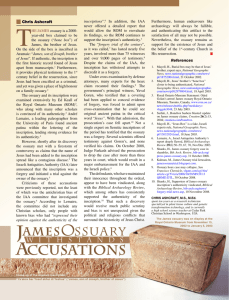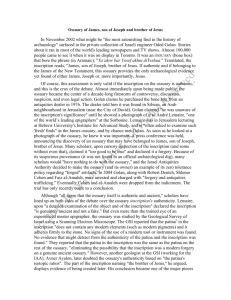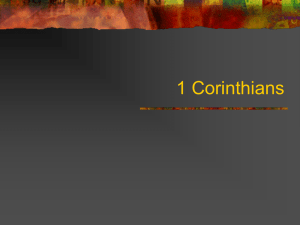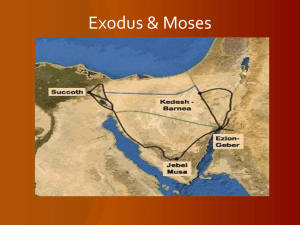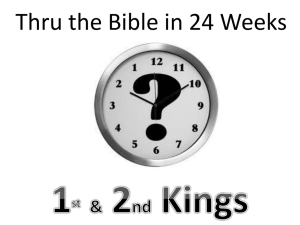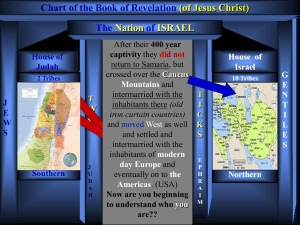Biblical Archaeology
advertisement
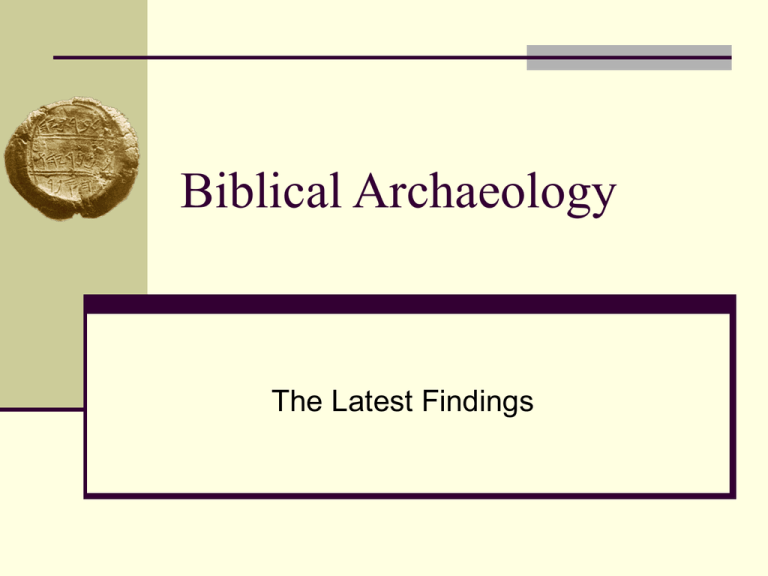
Biblical Archaeology The Latest Findings Timeline of Findings House of David (1994) Seal of Baruch Caiaphas’ Ossuary (1996) (1990) Nebuchadnezzar’s brick (1913) Pilate Inscription (1962) Peter’s house (1980/06) James’ Ossuary (2002) Crucified man (1968) 2 2010 2000 1990 1980 1970 1960 1950 1940 1930 1920 1910 1900 House in Egypt (1993) Seal of Ahaz (1998) 1913 - Nebuchadnezzar Brick The text reads: (1) nabu-kudurri.......................Nebuchadnezzar (2) lugal ba-bi-lu ki..................king of Babylon (3) za-nin e-sag-il......................provisioner of Esagil (4) u e-zi-da...............................and Ezida, (5) ap lu asharedu.....................prime son of (6) sha nabu-aplu-usur..............Nabopolassar (7) lugal ba-bi-lu ki...................king of Babylon (8) a na-?....................................I am, (9) e-ba-ra e sa-ma...................Ebarra temple of Shamash (10) lar-sa ki................................in Larsa (11) ?............................................as it was before, (12) sa-ma gi................................I restored for Shamash (13) ? lu........................................my Lord. 3 1962 - Pilate Inscription Discovered at Caesarea in secondary use in a later wall, this inscription bears witness to a major New Testament figure and settles the debate over Pilot’s title of Prefect rather than the inferior Procurator. 4 Pilate Inscription Line One: TIBERIEUM,, Line Two: (PON) TIUS Line Three: (PRAEF) ECTUS IUDA (EAE) Meaning - Pilate had "dedicated a Tiberium, a public structure built in honor of the Roman emperor Tiberius." This is the only known occurrence of the name Pontius Pilate in any ancient inscription. 5 Plus coins….. Judean bronze coin issued by Pilate in 30 CE. The Greek inscription reads (clockwise from the bottom left: Tiberiou [Ka]isaros ["of Tiberius Caesar"]. At the center is a lituus, a curved crook used by Roman augurs. Though this pagan religious symbol was used frequently on Roman coins minted outside Palestine, Pilate was the only Roman prefect to have put it on money issued for commerce among Jews. 6 1968 - Crucified Man An ossuary bearing the name "Yehochanan" contained the full skeleton of a man crucified in the first century and buried with a bent crucifixion nail through his heel bone. It is the only physical evidence of crucifixion ever discovered. 7 1980 - Peter’s House Capernaum 8 Peter’s House 9 Peter’s House 10 Peter’s House 11 Where Jesus stayed Jesus probably lived in Peter's house in Capernaum. Mt 4:13. Went and lived in Capernaum Mk 1:29-35. He stayed there that evening. Mk 2:1. “Home" probably same place. 12 1990 - Ossuary of Caiaphas 13 Ossuary of Caiaphas 14 Ossuary of Caiphas 15 1990 - Ossuary of Caiaphas From the Caiaphas family tomb in Jerusalem, this ossuary bears the inscription "Yehosef bar Qafa: (Joseph, son of Caiaphas), and it is dated to the Second Temple Period. Caiaphas is the name of the High Priest who presided over the trial of Jesus. 16 Ossuary of Caiaphas Ossuary contained the bones of a man of about 60 years old, a woman, two children and two infants. 17 Ossuary of Caiaphas 18 Caiphas Tomb – Other Artifacts 19 1993 - Ancient Israelite House in Egypt? Discovered at old capital – Thebes (1200- 1000 BC) “The layout of this building bears no similarity to any of the Egyptian house types in the New Kingdom.” Instead “the arrangement of the rooms bears….a high degree of similarity to the so called Iron-Age Four Room house of Palestine”. 20 Ancient Israelite House 21 House found in Egypt Typical Four-Room Israelite House 1994 - House of David Inscription Tel Dan Inscription 22 Was no evidence of David’s existence for a long time In 1993 a stone inscrption was found at Dan Appears to commemorate the victory of an Aramean king over the kingdoms of Israel and Judah In 1994 they found two more pieces which linked to the first piece and gave the names of the kings – Israel – “Jehoram” and Judah – “Ahaziah”. The new lines read –”I killed Jehoram son of Ahab king of Israel and I killed Ahaiahu son of Jehoram king of the House of David” (2Kings 8v28-29 – Recorded here this find is Hazael’s account – actually the two kings were killed just after the battle by Jehu – 2Kings 9:21-24,27) House of David 23 House of David The inscription found at Tel-Dan, however debatable the specifics, is the oldest extra- Biblical reference to Israel in semitic script. It succeeds in bridging the Biblical narrative testimony with archaeological evidence that "proves" that the kingdoms of Israel and Judah not only existed but were important kingdoms of the time. (http://www.otal.umd.edu/~knoblo ch/dan.htm) 24 1996 - Seal of Baruch Found in 1975 – but significance only came to light in 1996. “(Belonging) to Berekhyahu, the son of Neriyahu, the scribe.” The suffix -yahu was a common epithet attached to names in Judah, meaning, “blessed of Jehovah.” As a scribe of the Prophet Jeremiah, Baruch, the son of Neriah, is mentioned no less than thrity-two times in the Bible. He played a crucial role in the life and activities of the Prophet, and is considered one of the main sources of the Book. (Jer. 36:4) 26 Fingerprint of Baruch What is unique about this is the clear impression of a fingerprint on the upper left of the bulla. The article suggested this was the “fingerprint of Jeremiah’s scribe.” 3 Discoveries such as this remind us that the people of the Bible were not imaginary figures from fairy tales, but real people who served our God in the past. 27 1998 - Ahaz’s Seal 2 Chr 27:9 “Belonging to Ahaz (son of) Yehotam, King of Judah” First to be attributed to a biblical king Note fingerprint Bottom shows imprint of strings that tied the scroll together and the texture of the papyrus beneath 28 2002 – James’ Ossuary The letters etched into this ancient limestone object read, 'James, son of Joseph, brother of Jesus.' Mk 6;3 29 2002 – James’ Ossuary Earliest mention of Jesus outside the Bible Scans by electron microscope sho no trace of modern tools Grammer and script appear to fit normal useage of the period Are these John, James and Jospeh of the Bible? Common names Some stats – 40,000 men in Jerusalem at the time, suggested 20 people could fit this description – but mention of brother is highly unusual on ossuaries – only if famous are mentioned Could be the “nail in the coffin” for the Catholic debate that James was actually the cousin of Jesus 30 2002 – James’ Ossuary Aramaic inscription "Ya'akov bar Yosef akhui di Yeshua." 31 Fact or Fake? 32 FAKE - A committee appointed by the Israel Antiquities Authority (IAA) has declared the inscription on an ancient bone box that refers to "James, son of Joseph, brother of Jesus" to be a modern forgery. FACT - Two other groups of specialists—from the Geological Survey of Israel and the Royal Ontario Museum, in Toronto—also studied the bone box and concluded the inscription was ancient. And some of the world’s leading paleographers— specialists in ancient scripts—have dated the inscription’s style of writing to the first century A.D.
